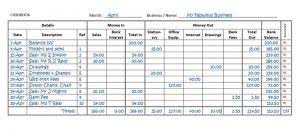
A much more sophisticated measure of a state’s tax burden is to look at how much a typical taxpayer actually pays. The following chart measures the state and local tax burden for a household earning the median income in the United States. Profit and prosper with the best of Kiplinger’s advice on investing, taxes, retirement, personal finance and much more. Additionally, the lowest tax rate in the state is 4.75%, which is relatively high.
- 6941, Connecticut legislators reduced individual income tax rates for the two lowest brackets, from 3 percent to 2 percent and from 5 percent to 4.5 percent, respectively.
- But you’ll likely pay more than that if you’re a millionaire.
- Coupled with its favorable climate and relatively lower tax obligations, Florida remains an attractive destination for many.
- The design and symbolism of flags can reflect a place’s history, culture, and values, and can also have a significant impact on national identity and international relations.
- Five other states — Arizona, Louisiana, Mississippi, New Mexico, and Oklahoma — had tax burdens between 1.0% and 2.0%.
Self-Employed Tax Deductions Calculator
- In March 2024, legislation was enacted reducing Utah’s individual and corporate income tax rates from 4.65 to 4.55 percent, retroactively effective as of January 1, 2024.
- The top tax rate in Massachusetts is 9%, making The Bay State the seventh highest in state income taxes.
- And some states apply their tax rates to taxable income, while others use adjusted gross income.
- Returns are also required by partnerships doing business in the state.
Most tax authorities have appeals procedures for audits, and all states permit taxpayers to go to court in disputes with the tax authorities. All states have a statute of limitations prohibiting the state from adjusting taxes beyond a certain period following filing returns. Based on this chart, New Hampshire taxpayers with median incomes pay 14.1% of their income in state and local taxes.

Capital gains taxes
- In 2022, the average New Hampshirite paid just $110 — or 0.1% of their income — in state income taxes.
- For example, the top rate kicks in at or above $1 million in California (when the “millionaire’s tax” surcharge is included), Massachusetts, New Jersey, New York, and the District of Columbia.
- Some are levied directly from residents and others are levied indirectly.
- WalletHub released a new study examining which states had the highest and lowest state and local tax rates to determine where residents are giving the most and least money back to their respective governments.
- However, the state’s diverse economy, cultural attractions, and access to world-class amenities may provide residents with opportunities that help offset some of these tax costs.
- Because of these exemptions, and ranking the “lowest” of the high-income tax rates, Vermont may be one of the more optimal states on this list to retire.
Location is everything if you want to save a few income tax dollars. Economic factors also weigh in; states may lower rates to invigorate growth or Bookkeeping for Painters increase them during economic downturns. Ultimately, changes in tax rates are a balancing act intended to provide necessary public services while keeping the state attractive for living and business. Tax systems differ, with some states applying a flat tax rate to all residents, while others use progressive rates that increase as income rises. The choice between these systems reflects the state’s financial strategy and the political environment shaped by public opinion and elected officials. The tax rate may be fixed for all income levels and taxpayers of a certain type, or it may be graduated.

How the 50 States Rank By State and Local Tax Rates in 2025
However, state income tax rates tend to be lower than federal tax rates. Many range between 1% and 10%, and some states don’t tax anything on the first few thousand dollars of income. The idea of not having to pay state income taxes might sound appealing, but keep in mind that property taxes, sales taxes or other taxes and fees could be higher in those states. Effective January 1, 2024, the tax rate decreased from 4.75 percent to 4.5 percent.
This makes Wyoming an attractive option for those aiming to maximize their income. Other states have a top tax rate, but not all states have the same number of income brackets leading up to the top rate. For example, Hawaii has a top tax rate of 11% and 12 income brackets, while Iowa has a top tax rate of 8.53% and nine income brackets. Learn which states have the highest tax rates, no taxes, and flat taxes; and see a complete list of tax rates for every adjusting entries state in the union.

- Is much less favorable, at 4% for incomes $10,000 or less.
- For instance, New York City charges an additional income tax of up to 3.876%.
- However, before we delve into states with the highest income tax rates, let’s briefly review marginal taxes to understand how much you could pay if you reside in a high-income tax state.
- For example, some states have their own deductions and exemptions, others use rates based on the federal tax code, while other states don’t allow any deductions or exemptions.
- Michigan’s state and local tax rate is slightly above the national average, resulting in a moderate tax burden for residents.
States’ approaches to income taxes vary in other details as well. In a progressive individual or corporate income tax system, rates rise as income increases. It is sometimes referred to as a “hidden tax,” as it leaves taxpayers less well-off due to higher costs and “bracket creep,” while increasing the government’s spending power., while many others do not. Some states average state income tax tie their standard deductions and personal exemptions to the federal tax code, while others set their own or offer none at all. The federal Tax Cuts and Jobs Act of 2017 (TCJA) increased the standard deductionThe standard deduction reduces a taxpayer’s taxable income by a set amount determined by the government.

Tech/Business refers to the technology and business environment, including its innovation capacity, entrepreneurship, and competitiveness. This category includes metrics such as research and development spending, patent applications, ease of doing business, and access to finance. Law is the system of rules and regulations that govern human behavior and interactions within a society.